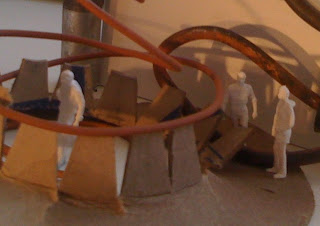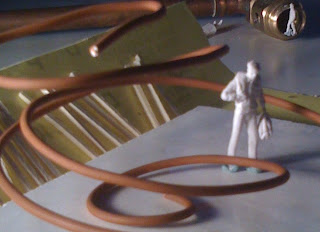Current project we are working on, includes several sites along the whole of the River Thames. Brentford and Kew, Chelsea and Battersea, Gravesend and Tilbury. My chosen site was the Brentford Dock Marina, and I am currently in the process of developing my masterplan for regenerating the area. I have opted to recreate the lost link between Brentford and Kew by re introducing the long lost Brentford Ferry. I am also using a series of floating boardwalks that interact with the users, and the tide, to create a series of connectable public spaces, that link onto a new Thames path, creating structure and flow, something that is missing, and has been for too long.
Ghaziri Thames Project
Camley Street Nature Reserve
Our first semester project, focused on the area around King's Cross railway, St. Pancreas and the Euro star. A hidden nature reserve, Camley can be found nearby, however it suffers from noise pollution, as well as actual pollution. It is currently under development, as a class we proposed sustainable masterplans to help with this process.
Ghaziri Camley Project
Ghaziri Camley Project
World's First Double Helix Bridge - Singapore


The worlds first 'Double Helix' bridge, surely will have taken inspiration from the previous first helix bridge. It is a 3.5 kilometer pedestrian path that creates a link around the new development 'Marina Bay' in Singapore. 'Inspired by the helicoidal structure of DNA, the pedestrian bridge stretches 280 meters over the bay and includes a computer-controlled lighting system to set the mood'. It is designed by Cox Group (Australian), Arup (UK/World), and Singaporean based, Architects 61. The opening is set for Saturday April the 24th, and is due to be wondrous.
http://inhabitat.com/2010/04/23/worlds-first-double-helix-pedestrian-bridge-opens-in-singapore/
World's First Helix Bridge - Vlaardingse Vaart


The worlds first helix bridge, built in Vlaardingen, Netherlands from 05-09. It is a pedestrian bicycle bridge, designed by West 8 urban architects.
'The bridge was prefabricated on site in a specially erected temporary shed of stacked containers. Its construction comprises 400 steel tubes that were welded together and then galvanized and painted red to create a unique and dynamic structure. The three-dimensional truss of the bridge twists on its horizontal axis. This twisted space frame construction absorbs the user in a continually changing experience of perspective. The rectangular frame at the bridge entrance evolves into a double-height diamond form in the middle. A transparent cathedral of steel becomes a new rest and meeting place along the footpaths and bicycle network.'
As different as it may be, for some reason it seems to create a flow, or that connection we are looking for. As it is a bridge at the end of the day, it is fulfilling its purpose of creating a link or connection, as well as representing the connection within us. Design that makes you think.
http://www.west8.nl/
Richmond Park - Management Plan
As part of our module, we were required to pick a space, and create a Management plan of the site, how the site is managed, what is included through the site, and how it is maintained. Types of species of wildlife and plantlife, as well as necessary precautions taken to ensure proper management.(Deer culling). Methods and techniques that are used, such as Pruning and coppicing, and exploration of Gantt Charts.
Ghaziri Richy Park Final
Ghaziri Richy Park Final
Focus Week 4 (01/03/10) - Blackpool Pleasure Beach





Whilst up north, we decided to take a trip to Blackpool pleasure beach, and luckily enough, I stumbled upon a couple of sculptures by David Harber.
I found 8 of his sculptures, that create an inviting and welcoming green space, designed to create a peaceful haven for people to sit and rest. Some water features, some sculptures, and others sun dials, David Harber tries to create an interaction between the sculptures, and the nature that surrounds them. He uses a wide range of metals and alloys mixed with granite, and water, pebbles and grass, to create a distortion of the nature that surrounds it, somewhat creating a desert mirage.. "each combining reflective mixed metal surfaces with the magic of surface tension to create a range of intriguing visual effects."
http://www.davidharbersundials.co.uk/news/blackpool.html
Focus Week 4 (01/03/10) - Warwick Castle

For our final focus week, I went up to Manchester to help coach and monitor with my brother and his football academy over from Beirut. I got to visit Warwick Castle for the first time, and witness the historic landscape first hand. There was plenty of reenactment of the 'robin hood' days, which was nothing new to me, as I had been to Nottingham Forest when I was young. However the vast space of green, surrounding this ancient ruin that has been preserved so well, created a breathtaking moment. I especially liked the way they integrated the castle with its natural surroundings and created flow, so as to make a whole.




Biomimicry - What can we learn from nature?
My dissertation on the natural world, natural design, Biomimicry, and how we can learn from nature to create a sustainable way of living.
Cs Essay Ghaziri Ld3004 Final Print
Cs Essay Ghaziri Ld3004 Final Print
Cradle to Cradle - William McDonough
Another talk from TEDtalks by William McDonough, on Green design.
Here he raises questions on design ethics and reasoning, and explores the way our lives would be, our products would look, our designs would feel, if designers took everyone and every living thing, for all of time, into account. The process of longevity with sustainable design.
Here he raises questions on design ethics and reasoning, and explores the way our lives would be, our products would look, our designs would feel, if designers took everyone and every living thing, for all of time, into account. The process of longevity with sustainable design.
The Aerogenerator

The Aerogenerator is a Grimshaw design for a new source of off shore energy creation inspired by the forms of sycamore seeds and beach pebbles. The device is designed to float (anchored) sso that it can be positioned far out into the sea, to receive the most powerful of sea winds. 'Each rotor arm is the same length as the Eiffel Tower is high. The output would exceed that of any conventional turbine constructed to date.'
Client - Windpower Limited (Theo Bird)
Aeronautical Engineer - David Sharp
Designers - Grimshaw (Eoin Billings, Duncan Jackson, Michael Pawlyn, Jonas Stedelik)
Structural Engineer - Atelier One
Janine Benyus - Biomimicry Continued
These are a some of the videos that gave me inspiration to research, discover, learn, and write about the developments of natural design.
"TEDTalks is a daily video podcast of the best talks and performances from the TED Conference, where the world's leading thinkers and doers are invited to give the talk of their lives in 18 minutes -including speakers such as Jill Bolte Taylor, Sir Ken Robinson, Hans Rosling, Al Gore and Arthur Benjamin. TED stands for Technology, Entertainment, and Design"
http://www.ted.com/index.php/talks/top10
"TEDTalks is a daily video podcast of the best talks and performances from the TED Conference, where the world's leading thinkers and doers are invited to give the talk of their lives in 18 minutes -including speakers such as Jill Bolte Taylor, Sir Ken Robinson, Hans Rosling, Al Gore and Arthur Benjamin. TED stands for Technology, Entertainment, and Design"
http://www.ted.com/index.php/talks/top10
Biomimicry
Biomimicry has quickly become somewhat one of my favourite topics, as the possibilities are endless, and it is always a pleasure learning from nature. I have recently written an extended essay, or dissertation on Biomimicry, the act of using nature as a blueprint for sustainable design, and how it has the potential to better our ways of living.
Janine Benyus is the founder and director of the Biomimicry Guild, and Biomimicry Institute, dedicated to meeting, discussing, and getting inspired, using nature as measure, model and mentor. She is the face of the Biomimicry movement across the globe.
Janine Benyus is the founder and director of the Biomimicry Guild, and Biomimicry Institute, dedicated to meeting, discussing, and getting inspired, using nature as measure, model and mentor. She is the face of the Biomimicry movement across the globe.
Surface and Texture Experiments



During studio, a few of us who were interested, were invited next door by Lucy Tauber to experiment with the effects of light on surfaces and textures to help us create spaces, atmospheres, and emotions that are created with the effect.
The trick is to get close enough and focused enough, so that the surroundings are not objects anymore, but more textures, surfaces and materials, which will then create images that act as good inspiration.
Focus Week -The Landscape Institute
Steve Cole, a member and Education and Career executive for the Landscape Institute dropped by to deliver a presentation on what it is like to work as a registered Landscape Architect as well as the processes required to become an established one throughout the country.
www.landscapeinstitute.org
We were all offered full and student memberships, as well as an invitation to the annual Eco-build gathering of seminars and green awareness talks, and the development of a sustainable future. One talk in particular was that of Michael Pawlyn, on Biomimicry and its potential positive impact on our future.
Michael runs 'Exploration Architecture' with a group of like minded individuals who are dedicated to devising solutions towards a better and more sustainable way of living through design.
www.exploration-architecture.com
www.ecobuild.co.uk



www.landscapeinstitute.org
We were all offered full and student memberships, as well as an invitation to the annual Eco-build gathering of seminars and green awareness talks, and the development of a sustainable future. One talk in particular was that of Michael Pawlyn, on Biomimicry and its potential positive impact on our future.
Michael runs 'Exploration Architecture' with a group of like minded individuals who are dedicated to devising solutions towards a better and more sustainable way of living through design.
www.exploration-architecture.com
www.ecobuild.co.uk



Focus Week 3 (25/01/10) - Serpentine Gallery





Design Real Exhibition - Konstantin Grcic
During this focus week, I visited the Serpentine Gallery in Hyde Park. The exhibition being shown was that of Konstantin Grcic, a german product designer, and was held from the 26th of November 09 to the 7th of February 10. At first, it took a while for me to grasp what was happening, but after reading into it, and listening to discussions in the gallery, I'd figured it out. It was a collection of industrial design objects or 'real items' that have been created in the past decade, which provide a vital function to our everyday life. Konstantin explores the process of pristine real design and its interaction with our lives, and how we can learn as well as become inspired by examining what the objects are made up of, and the thought processes that were taken to create it. This led me to think how essential it is we develop a critical design eye in the way we see the world. Instead of seeing a car as an object that moves us from place to place on four wheels, it should be examined from every angle, realizing how the design was approached, developed, and created. The end result is not as important as the thought process.
‘What interests me about industrial design is how these things are made, in what material, and how this has affected their language and their quality, Some objects are very technically-driven; the function really determines the object. Other objects have much more of a signature or an authorship; you see the handwriting of the designer who made it and that’s what makes it so special.’ - Konstantin Grcic
www.design-real.com
Subscribe to:
Posts (Atom)
